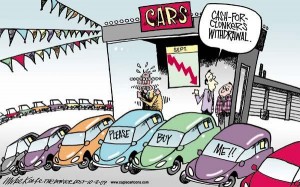NOTE: Every week I write a Client Note for my clients. For a limited time, I am allowing non-clients to sign up and receive the Client Note. You can sign up at the top right hand corner of the website. Here is this week’s.
*****
The Cash For Clunkers program was widely held as a smashing success with more than 700,000 vehicles sold with the rebates between July 27 and August 24. August 2009 auto sales were up 1% from the year ago period at 1,262,189.
Unfortunately, September auto sales plummetted as the Cash For Clunkers program expired. 745,997 new cars were sold in September – down 23% from last year. GM’s September sales were off 45%, Chrysler’s 42%, Honda’s 20%, Toyota’s 13% and Ford’s 5%. [NOTE: September 2008 wasn’t exactly a great month for new car sales either. Overall industry sales dropped 27% to 964,783 – the first month in which less than 1 million new cars were sold since February 1993]. That’s no surprise since any good economist would tell you that an incentive like Cash For Clunkers would pull sales from future months forward as consumers bought during the window in which they could receive the subsidy.

I write about this not because the $3 billion Cash For Clunkers program is so important to the overall economy but to illustrate a point. The economy right now is being fuelled by a massive array of stimulus programs analogous to Cash For Clunkers. Were the government to end these programs, the result would be very similar to what we just experienced with Cash For Clunkers.
The $8,000 1st time homebuyer tax credit and the Fed purchase of $1.45 billion of Fannie and Freddie debt and MBS come to mind because both are expiring in the near future. The tax credit expires on November 30, 2009 and the Fed is tapering off its purchases of the latter through the end of the first quarter of 2010. What happens to the home market and mortgage rates when these programs expire? Cash For Clunkers provides the answer. Of course, the government could just extend the programs or restart them at a later date.
Further, these subsidies and stimulus hardly exhaust the barrage currently in force. 0% Fed Funds Rate, $787 billion American Recovery and Re-Investment Act, TARP, TALF, etc…. All of these are propping up the economy and without them we’d fall back into the abyss of March.
Of course, the government won’t let that happen. They’ll prop up the economy by any means necessary, pushing off the day of reckoning into the future. At some point, however, the power to do so could be taken out of their hands. Everything depends on the dollar and its role as the reserve currency of the global economy.
This status is very much in jeopardy and was even a big story in the market today as a report circulated that Middle East oil producers are in the process of making a deal with China, Russia and others to price oil against a basket of currencies and gold instead of the dollar (see
“Independent: Middle East In Talks With China, Russia To End Dollar Dealing For Oil”, Top Gun FP, October 6). No wonder gold hit an all time high today of $1045/oz.
Should the dollar come under serious pressure in the foreign exchange markets, the day of reckoning will be upon us and the power to prop up the economy taken out of the hands of our policy makers. If/when that happens and how all this plays out nobody knows. But there is No Free Lunch, as we all learned in our college Economics courses, and there is a price to be paid for all this stimulus and bailouts.
*****
A couple of bellwether stocks reported earnings last Tuesday: Nike (NKE) and Darden Restaurants (DRI).
Nike reported a 12% decrease in sales, from $5.4 billion to $4.8 billion, for the period ended August 31, 2009. Future orders scheduled for delivery from September 2009 through January 2010 were off 6% compared to the year ago period. Earnings Before Interest And Taxes (EBIT), a good measure of the operations of the core business, were off 3% from the year ago period.
Darden, operator of The Olive Tree and Red Lobster, reported a -5.3% blended same store sales decline. Overall revenues were down 2% but they were able to increase net income and EPS due to a 3% decrease in total expenses and a better tax rate compared to the year ago period.
Neither stock is especially expensive with Nike trading at 15.7 times estimated earnings for their fiscal year ending May 30, 2010 and Darden 12.6 times their guidance for the fiscal year that ends the same date as Nike’s. (I backed out $6 in net cash and short term investments in calculating Nike’s forward P/E. Darden’s balance sheet is weaker with more than $1.7 billion in debt and only $79 million in cash). But neither is that especially cheap for consumer discretionary companies selling products with elastic demand and notably declining revenues in a tough economic environment. A case can be made either way, based on valuation, but to me these stocks are both mild Sells at these levels based on the economy.
From a bigger picture perspective, neither report shows signs of a recovering economy – though they don’t show precipitous decline either.
Greg Feirman
Founder & CEO
A Registered Investment Advisor
9700 Village Center Dr. #50H
Granite Bay CA 95746
(916) 224-0113
CALL NOW FOR A FREE INITIAL CONSULTATION!

